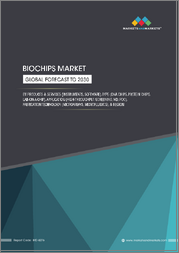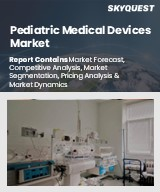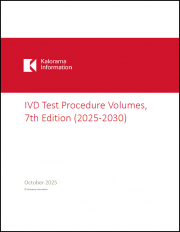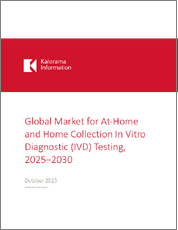
|
시장보고서
상품코드
1677088
세계의 체외 마이크로 전극 어레이 시장 : 제품 유형, 용도, 최종사용자별 - 예측(2025-2030년)In vitro Micro Electrode Array Market by Product, Type, Application, End-User - Global Forecast 2025-2030 |
||||||
체외 마이크로 전극 어레이 시장은 2024년 1억 1,445만 달러에서 2025년에는 1억 2,013만 달러에 이르고, 5.18%의 연평균 복합 성장률(CAGR)로 성장하여 2030년에는 1억 5,501만 달러에 달할 것으로 예상됩니다.
| 주요 시장 통계 | |
|---|---|
| 기준 연도 : 2024년 | 1억 1,445만 달러 |
| 추정 연도 : 2025년 | 1억 2,013만 달러 |
| 예측 연도 : 2030년 | 1억 5,501만 달러 |
| CAGR(%) | 5.18% |
빠르게 발전하는 생물 의학 연구의 세계에서 체외 마이크로 전극 어레이(MEA)는 세포의 전기적 활동을 분석하는 중요한 도구로 등장했습니다. 이 기술은 기존의 실험 패러다임을 파괴했을 뿐만 아니라 신경과학, 신약개발, 조직공학의 최첨단 개발의 길을 열었습니다. 이 분석의 초점은 의사 결정자와 전문가에게 현재 시장 동향, 변혁적 변화 및 MEA의 다양한 용도를 보여주는 세분화 전략에 대한 종합적인 견해를 제공하는 것입니다.
이러한 플랫폼의 채택이 급증하고 있는 배경에는 기술 발전과 세포 생물학 분야의 정확한 실시간 데이터에 대한 수요가 증가하고 있기 때문입니다. 연구자, 임상의, 업계 임원들은 현재 획기적인 치료법과 새로운 과학적 발견으로 이어질 수 있는 통찰력을 얻기 위해 정교한 장비와 소모품에 의존하고 있습니다. 시장이 디지털화, 소형화, 자동화 추세와 함께 움직이고 있는 가운데, in vitro MEA 기술은 고처리량 스크리닝 및 고급 모델링 시스템에서 혁명을 일으키고 있습니다.
이 보고서는 시장을 관련 하위 범주로 분류하여 이해관계자들에게 제품 유형, 용도, 지역 역학에 대한 세부적인 관점을 제공함으로써 그 토대를 마련합니다. 과학적 전문 지식과 상업적 요구의 융합을 강조함으로써 이 분석은 기술 혁신과 시장 수요의 결합을 이해하는 단계를 설정합니다. 또한, 주요 기술 발전과 향후 몇 년간의 전략적 전망을 형성하는 충격적인 변화를 강조합니다.
체외 마이크로 전극 어레이의 판도를 뒤바꿀 혁신적 변화!
최근 체외 마이크로 전극 어레이 시장의 혁신적인 변화는 현대 생의학 연구와 임상 응용의 경계를 재정의하고 있습니다. 기술 혁신은 실험의 성공과 신뢰할 수 있는 데이터 수집에 필수적인 진전을 가져왔습니다. 속도, 정확성, 효율성을 중시하는 시장에서 최첨단 기록 및 자극 시스템의 통합은 사용자 중심 설계의 출현을 가속화하고 있습니다.
소모품 및 장비의 혁신은 데이터 수집 정확도를 크게 향상시켜 연구자들이 전례 없이 세밀하게 세포 반응을 관찰하고 측정할 수 있게 되었습니다. 시장 요구의 변화에 따라 공급업체들은 MEA 플랫폼의 장기적인 안정성과 재현성을 보장하기 위해 정교한 세척 및 유지보수 키트와 특수 시약 및 배지를 제공하게 되었습니다. 멀티웰 및 싱글웰 포맷이 계속 발전함에 따라, 사용자는 실험 요구사항과 정밀하게 설계된 플랫폼 간의 일관성을 높일 수 있게 되었습니다.
동시에 디지털 분석과 자동화의 도입은 전 세계 실험실의 업무 효율성을 혁신적으로 변화시켰습니다. 학술 기관과 상업 기관 모두 이러한 혁신을 채택하고 연구 성과를 가속화하기 위해 강력한 데이터 분석과 통합 시스템 설계의 중요성이 강조되면서 시장 역학이 빠르게 변화하고 있습니다. 이러한 변화하는 상황에서 전략적 협업과 기술 파트너십은 지속가능성을 보장하고, 혁신을 촉진하며, 새로운 연구 요구에 빠르게 적응할 수 있는 유연한 환경을 조성하는 중요한 원동력으로 부상하고 있습니다.
체외 마이크로 전극 어레이 시장의 상세한 세분화 인사이트
체외 마이크로 전극 어레이 시장의 세분화는 다양한 응용 분야와 잠재적 성장 경로를 이해하는 데 필수적입니다. 제품 분류의 렌즈를 통해 볼 때, 시장은 소모품과 기기로 나뉘어진 광범위한 시야를 제공합니다. 소모품 영역에서는 세척 및 유지보수 키트, MEA 플레이트 또는 칩, 시약 및 배지에 대한 광범위한 조사가 집중되어 있습니다. 이러한 분야는 실험 중 작업의 무결성과 정확성을 보장하는 데 필수적입니다. 장비 측면에서는 MEA 기록 시스템 및 자극 시스템의 혁신이 데이터 수집 및 분석을 강화하는 초석이 되었습니다.
유형에 따라 세분화하면 시장은 멀티웰과 싱글웰 마이크로 전극 어레이로 나뉩니다. 멀티웰 구성은 병렬 처리 능력으로 인해 높은 처리량의 데이터를 생성할 수 있기 때문에 선호되는 반면, 단일 웰 설정은 집중적인 정확도와 상세한 신호 분석을 위해 종종 선택됩니다. 용도 중심의 요구사항에 따라 이 시장은 질병 모델링, 신약 개발, 신경과학 탐색, 조직공학, 독성학 검사에서 매우 중요한 역할을 수행함으로써 차별화를 꾀하고 있습니다. 이러한 광범위한 응용 범위로 인해 MEA 기술은 방대한 연구 수요를 충족시킬 수 있을 뿐만 아니라 생의학 분야의 새로운 과제와 기회에 역동적으로 적응할 수 있습니다.
세분화 프레임워크에는 학술 연구 기관, 생명공학 기업, 제약회사가 주요 소비자로 밀접하게 연계된 최종 사용자에 기반한 평가도 포함되어 있습니다. 각 부문은 엄격한 학문적 탐구에서 간소화된 산업 생산 공정에 이르기까지 명확한 니즈를 강조하고 있습니다. 이러한 계층적 세분화 접근 방식은 현재 시장 생태계의 복잡성과 상호 연관성을 모두 반영하는 종합적인 관점을 제공합니다.
목차
제1장 서문
제2장 조사 방법
제3장 주요 요약
제4장 시장 개요
제5장 시장 인사이트
- 시장 역학
- 성장 촉진요인
- 성장 억제요인
- 기회
- 과제
- 시장 세분화 분석
- Porter's Five Forces 분석
- PESTEL 분석
- 정치
- 경제
- 사회
- 기술
- 법률
- 환경
제6장 체외 마이크로 전극 어레이 시장 : 제품별
- 소모품
- 클리닝 및 메인터넌스 키트
- MEA 플레이트/칩
- 시약 및 배지
- 기기
- MEA 기록 시스템
- MEA 자극 시스템
제7장 체외 마이크로 전극 어레이 시장 : 유형별
- 멀티웰 마이크로 전극 어레이
- 싱글웰 마이크로 전극 어레이
제8장 체외 마이크로 전극 어레이 시장 : 용도별
- 질환 모델
- Drug Discovery
- 신경과학
- 조직공학
- 독성시험
제9장 체외 마이크로 전극 어레이 시장 : 최종사용자별
- 학술연구기관
- 바이오테크놀러지 기업
- 제약회사
제10장 아메리카의 체외 마이크로 전극 어레이 시장
- 아르헨티나
- 브라질
- 캐나다
- 멕시코
- 미국
제11장 아시아태평양의 체외 마이크로 전극 어레이 시장
- 호주
- 중국
- 인도
- 인도네시아
- 일본
- 말레이시아
- 필리핀
- 싱가포르
- 한국
- 대만
- 태국
- 베트남
제12장 유럽, 중동 및 아프리카의 체외 마이크로 전극 어레이 시장
- 덴마크
- 이집트
- 핀란드
- 프랑스
- 독일
- 이스라엘
- 이탈리아
- 네덜란드
- 나이지리아
- 노르웨이
- 폴란드
- 카타르
- 러시아
- 사우디아라비아
- 남아프리카공화국
- 스페인
- 스웨덴
- 스위스
- 터키
- 아랍에미리트(UAE)
- 영국
제13장 경쟁 구도
- 시장 점유율 분석, 2024
- FPNV 포지셔닝 매트릭스, 2024
- 경쟁 시나리오 분석
- 전략 분석과 제안
기업 리스트
- 3Brain AG
- Alpha MED Scientific, Inc.
- Axion BioSystems, Inc.
- Blackrock Microsystems LLC
- BMSEED LLC
- FHC, Inc.
- Innovative Neurophysiology Inc.
- MaxWell Biosystems AG
- MicroElectrodeDevices MED sarl
- Microprobes for Life Science
- Multi Channel Systems MCS GmbH
- NETRI
- Neuralynx, Inc.
- NMI Technologie Transfer GmbH
- Plexon Inc.
- Screen Holdings Co. Ltd
- STEMCELL Technologies Canada Inc.
- Tucker-Davis Technologies
- World Precision Instruments
The In vitro Micro Electrode Array Market was valued at USD 114.45 million in 2024 and is projected to grow to USD 120.13 million in 2025, with a CAGR of 5.18%, reaching USD 155.01 million by 2030.
| KEY MARKET STATISTICS | |
|---|---|
| Base Year [2024] | USD 114.45 million |
| Estimated Year [2025] | USD 120.13 million |
| Forecast Year [2030] | USD 155.01 million |
| CAGR (%) | 5.18% |
In the rapidly evolving world of biomedical research, in vitro micro electrode arrays (MEAs) have emerged as critical tools for analyzing cellular electrical activities. This technology has not only disrupted traditional experimental paradigms but has also paved the way for cutting-edge developments in neuroscience, drug discovery, and tissue engineering. The focus of this analysis is to provide decision-makers and experts with a comprehensive view of current market trends, transformative shifts, and the segmentation strategies that underline the diverse applications of MEAs.
The tremendous growth in the adoption of these platforms is driven by the convergence of technological advancements and the increasing demand for precise, real-time data in cellular biology. Researchers, clinicians, and industry executives now rely on sophisticated instrumentation and consumables to glean insights that lead to groundbreaking therapies and novel scientific discoveries. As the market moves in tandem with the trends of digitization, miniaturization, and automation, the in vitro MEA technology stands at the cusp of a revolution in high-throughput screening and advanced modeling systems.
This report lays a foundation by dissecting the market into relevant sub-categories, offering stakeholders a granular perspective on product types, applications, and regional dynamics. By underscoring the convergence of scientific expertise and commercial imperatives, the analysis sets a stage for understanding the confluence of innovation with market demand. It further highlights the key technological advancements and the impactful changes shaping the strategic landscape for years to come.
Transformative Shifts Shaping the In Vitro Micro Electrode Array Landscape
Recent transformative shifts in the in vitro micro electrode array market are redefining the boundaries of modern biomedical research and clinical applications. Technological innovation has precipitated advancements that are now integral for successful experimentation and reliable data acquisition. In a market that values speed, accuracy, and efficiency, the integration of state-of-the-art recording and stimulation systems is accelerating the emergence of user-centric designs.
Innovation in both consumables and instruments has led to substantial improvements in data capture accuracy, enabling researchers to observe and measure cellular responses with unprecedented detail. Changes in market requirements have driven suppliers to offer sophisticated cleaning and maintenance kits and specialized reagents and media that ensure the long-term stability and reproducibility of MEA platforms. As multiwell and single-well formats continue to evolve, users can now better align their experimental needs with precisely engineered platforms.
Concurrently, the infusion of digital analytics and automation has transformed operational efficiencies in laboratories worldwide. Market dynamics are quickly shifting as both academic and commercial entities adopt these innovations, emphasizing the importance of robust data analytics and integrated system design in accelerating research outcomes. In this evolving landscape, strategic collaborations and technological partnerships are emerging as key drivers that ensure sustainability, foster innovation, and create a flexible environment for rapid adaptation to emerging research needs.
In-Depth Segmentation Insights in the In Vitro Micro Electrode Array Market
The segmentation of the in vitro micro electrode array market is integral to understanding its diverse applications and potential growth avenues. When viewed through the lens of product categorization, the market offers an expansive view split across consumables and instruments. Within the realm of consumables, extensive research focuses on cleaning and maintenance kits, MEA plates or chips, as well as reagents and media. These segments are critical to ensuring operational integrity and accuracy during experimentation. On the instrumentation side, innovations in MEA recording systems and stimulation systems serve as the cornerstone for enhanced data collection and analysis.
Further segmentation based on type divides the market into multiwell and single-well micro electrode arrays. The multiwell configurations are prized for their parallel processing capabilities, enabling high-throughput data generation, while single-well setups are often selected for their concentrated accuracy and detailed signal analysis. In alignment with application-driven requirements, the market differentiates itself through pivotal roles in disease modeling, drug discovery, neuroscience exploration, tissue engineering, and toxicology testing. This breadth of application ensures that MEA technology not only serves a vast array of research needs but also adapts dynamically to emerging challenges and opportunities in the biomedical landscape.
The segmentation framework also includes an assessment based on the end-user, where academic and research institutes, biotechnology companies, and pharmaceutical companies collaborate closely as principal consumers. Each of these segments underscores distinct needs ranging from rigorous academic exploration to streamlined industrial production processes. This layered segmentation approach provides a comprehensive view that reflects both the complexity and the interconnectedness of the current market ecosystem.
Based on Product, market is studied across Consumables and Instruments. The Consumables is further studied across Cleaning & Maintenance Kits, MEA Plates/Chips, and Reagents & Media. The Instruments is further studied across MEA Recording Systems and MEA Stimulation Systems.
Based on Type, market is studied across Multiwell Microelectrode Arrays and Single-Well Microelectrode Arrays.
Based on Application, market is studied across Disease Modeling, Drug Discovery, Neuroscience, Tissue Engineering, and Toxicology Testing.
Based on End-User, market is studied across Academic & Research Institutes, Biotechnology Companies, and Pharmaceutical Companies.
Global Regional Insights: Trends Across Americas, Europe, Middle East & Africa, and Asia-Pacific
The in vitro micro electrode array market presents a varied and dynamic profile across global regions. In the Americas, robust infrastructure, advanced research facilities, and a deep-rooted focus on biomedical innovation have anchored significant growth and technological advancement. The regional landscape benefits from strong relationships between academia and industry, enabling swift translation of laboratory breakthroughs into clinical and commercial applications.
In the combined regions of Europe, the Middle East, and Africa, research institutions and innovation hubs have fostered a progressive approach to technology adoption. European laboratories, in particular, exhibit a strong alignment with regulatory frameworks that encourage high standards and reliable data collection. Meanwhile, the markets in the Middle East and Africa are increasingly embracing advanced MEA technologies as part of broader biomedical initiatives that aim to improve overall healthcare outcomes.
Asia-Pacific is emerging as a powerhouse with significant investments in research and development. The region's rapid industrialization, coupled with proactive governmental policies and a large pool of skilled scientific talent, has accelerated the integration of MEA systems in both academic and commercial sectors. These global regional insights reveal that while each geographic area faces unique challenges, they collectively contribute to a thriving and adaptive market framework that is set to redefine the future of in vitro research technologies.
Based on Region, market is studied across Americas, Asia-Pacific, and Europe, Middle East & Africa. The Americas is further studied across Argentina, Brazil, Canada, Mexico, and United States. The United States is further studied across California, Florida, Illinois, New York, Ohio, Pennsylvania, and Texas. The Asia-Pacific is further studied across Australia, China, India, Indonesia, Japan, Malaysia, Philippines, Singapore, South Korea, Taiwan, Thailand, and Vietnam. The Europe, Middle East & Africa is further studied across Denmark, Egypt, Finland, France, Germany, Israel, Italy, Netherlands, Nigeria, Norway, Poland, Qatar, Russia, Saudi Arabia, South Africa, Spain, Sweden, Switzerland, Turkey, United Arab Emirates, and United Kingdom.
Leading Companies Driving Innovation in In Vitro Micro Electrode Arrays
An array of pioneering companies is at the forefront of research and product development within the in vitro micro electrode array space. Market leaders such as 3Brain AG, Alpha MED Scientific, Inc., and Axion BioSystems, Inc. have crafted strategies that integrate both innovative design and scalable production. In addition, Blackrock Microsystems LLC and BMSEED LLC bring forward dynamic instrument solutions that cater to the ever-growing needs of sophisticated laboratories.
Other notable contributors include FHC, Inc. and Innovative Neurophysiology Inc., who are continuously pushing the boundaries of technology through focused research and development programs. The commitment of companies like MaxWell Biosystems AG and MicroElectrodeDevices MED sarl is further exemplified by their persistent quest for accuracy and reproducibility in data capture. Microprobes for Life Science, as well as Multi Channel Systems MCS GmbH and NETRI, offer refined technologies that meet the rigorous demands of high-resolution recording and stimulation systems.
This competitive landscape is enriched by industry trailblazers such as Neuralynx, Inc., NMI Technologie Transfer GmbH, and Plexon Inc., who consistently deliver state-of-the-art solutions. The contributions of Screen Holdings Co. Ltd, STEMCELL Technologies Canada Inc., Tucker-Davis Technologies, and World Precision Instruments further illustrate how innovation, collaboration, and a deep understanding of market demands are shaping the future of in vitro micro electrode arrays. Their collective efforts not only set benchmarks for excellence but also assist in the broader adoption of these versatile technologies across research and commercial sectors.
The report delves into recent significant developments in the In vitro Micro Electrode Array Market, highlighting leading vendors and their innovative profiles. These include 3Brain AG, Alpha MED Scientific, Inc., Axion BioSystems, Inc., Blackrock Microsystems LLC, BMSEED LLC, FHC, Inc., Innovative Neurophysiology Inc., MaxWell Biosystems AG, MicroElectrodeDevices MED sarl, Microprobes for Life Science, Multi Channel Systems MCS GmbH, NETRI, Neuralynx, Inc., NMI Technologie Transfer GmbH, Plexon Inc., Screen Holdings Co. Ltd, STEMCELL Technologies Canada Inc., Tucker-Davis Technologies, and World Precision Instruments. Strategic Recommendations for Visionary Industry Leaders
Industry leaders need to focus on strategic investments that fortify both research capabilities and market reach. It is recommended that companies leverage advancements in data integration and automation to enhance operational efficiencies and reduce cycle times. Fostering strategic alliances with technology innovators and academic institutions can bridge the gap between research and application, ensuring that product development is both responsive and future-oriented.
Leaders are encouraged to closely monitor evolving regulatory standards and scientific protocols, as staying compliant and adaptive serves as a cornerstone for long-term success. Investing in robust, modular product architecture that allows for upgrades and customization will also help maintain competitive relevance. Additionally, prioritizing customer feedback and incorporating iterative design improvements can accelerate the pace of innovation. Such focused initiatives will not only enhance the quality and reliability of in vitro MEA systems but also contribute to building a resilient and adaptable market presence.
Executive Summary Conclusion and Final Considerations
The executive summary offers a panoramic view of the in vitro micro electrode array market, emphasizing significant trends, in-depth segmentation, and regional variations that collectively shape the industry's trajectory. Through detailed analysis, it is evident that the unique integration of advanced consumables and high-precision instruments is unlocking new potentials in cellular and molecular research.
The exploration of market segments-ranging from product types and application areas to diverse end-user groups-reveals a sophisticated ecosystem where each component plays a vital role. Furthermore, regional insights highlight a dynamic interplay of innovation and regulatory evolution across continents, reinforcing the global significance of these technologies.
In conclusion, the synthesis of market trends, strategic insights from leading companies, and actionable recommendations underlines the importance of agility and collaboration in sustaining long-term success. As the sector continues to evolve, stakeholders will benefit from a proactive approach that embraces both technological advancements and market diversification.
Table of Contents
1. Preface
- 1.1. Objectives of the Study
- 1.2. Market Segmentation & Coverage
- 1.3. Years Considered for the Study
- 1.4. Currency & Pricing
- 1.5. Language
- 1.6. Stakeholders
2. Research Methodology
- 2.1. Define: Research Objective
- 2.2. Determine: Research Design
- 2.3. Prepare: Research Instrument
- 2.4. Collect: Data Source
- 2.5. Analyze: Data Interpretation
- 2.6. Formulate: Data Verification
- 2.7. Publish: Research Report
- 2.8. Repeat: Report Update
3. Executive Summary
4. Market Overview
5. Market Insights
- 5.1. Market Dynamics
- 5.1.1. Drivers
- 5.1.1.1. Rising prevalence of neurological disorders globally
- 5.1.1.2. Burgeoning demand for drug discovery and toxicity testing
- 5.1.1.3. Expansion of stem cell research and regenerative medicine worldwide
- 5.1.2. Restraints
- 5.1.2.1. Regulatory and compliance requirements associated with in-vitro micro electrode arrays
- 5.1.3. Opportunities
- 5.1.3.1. Integrating IoT capabilities in in vitro microelectrode array technology
- 5.1.3.2. Ongoing advancements in precision medicine using in vitro microelectrode arrays
- 5.1.4. Challenges
- 5.1.4.1. Data security and privacy concerns related to sensitive in vitro experiment data
- 5.1.1. Drivers
- 5.2. Market Segmentation Analysis
- 5.2.1. Product: Increasing adoption of MEA stimulation systems in pharmacology and regenerative medicine
- 5.2.2. Application: Expanding application of in vitro micro electrode array in drug discovery sector
- 5.3. Porter's Five Forces Analysis
- 5.3.1. Threat of New Entrants
- 5.3.2. Threat of Substitutes
- 5.3.3. Bargaining Power of Customers
- 5.3.4. Bargaining Power of Suppliers
- 5.3.5. Industry Rivalry
- 5.4. PESTLE Analysis
- 5.4.1. Political
- 5.4.2. Economic
- 5.4.3. Social
- 5.4.4. Technological
- 5.4.5. Legal
- 5.4.6. Environmental
6. In vitro Micro Electrode Array Market, by Product
- 6.1. Introduction
- 6.2. Consumables
- 6.2.1. Cleaning & Maintenance Kits
- 6.2.2. MEA Plates/Chips
- 6.2.3. Reagents & Media
- 6.3. Instruments
- 6.3.1. MEA Recording Systems
- 6.3.2. MEA Stimulation Systems
7. In vitro Micro Electrode Array Market, by Type
- 7.1. Introduction
- 7.2. Multiwell Microelectrode Arrays
- 7.3. Single-Well Microelectrode Arrays
8. In vitro Micro Electrode Array Market, by Application
- 8.1. Introduction
- 8.2. Disease Modeling
- 8.3. Drug Discovery
- 8.4. Neuroscience
- 8.5. Tissue Engineering
- 8.6. Toxicology Testing
9. In vitro Micro Electrode Array Market, by End-User
- 9.1. Introduction
- 9.2. Academic & Research Institutes
- 9.3. Biotechnology Companies
- 9.4. Pharmaceutical Companies
10. Americas In vitro Micro Electrode Array Market
- 10.1. Introduction
- 10.2. Argentina
- 10.3. Brazil
- 10.4. Canada
- 10.5. Mexico
- 10.6. United States
11. Asia-Pacific In vitro Micro Electrode Array Market
- 11.1. Introduction
- 11.2. Australia
- 11.3. China
- 11.4. India
- 11.5. Indonesia
- 11.6. Japan
- 11.7. Malaysia
- 11.8. Philippines
- 11.9. Singapore
- 11.10. South Korea
- 11.11. Taiwan
- 11.12. Thailand
- 11.13. Vietnam
12. Europe, Middle East & Africa In vitro Micro Electrode Array Market
- 12.1. Introduction
- 12.2. Denmark
- 12.3. Egypt
- 12.4. Finland
- 12.5. France
- 12.6. Germany
- 12.7. Israel
- 12.8. Italy
- 12.9. Netherlands
- 12.10. Nigeria
- 12.11. Norway
- 12.12. Poland
- 12.13. Qatar
- 12.14. Russia
- 12.15. Saudi Arabia
- 12.16. South Africa
- 12.17. Spain
- 12.18. Sweden
- 12.19. Switzerland
- 12.20. Turkey
- 12.21. United Arab Emirates
- 12.22. United Kingdom
13. Competitive Landscape
- 13.1. Market Share Analysis, 2024
- 13.2. FPNV Positioning Matrix, 2024
- 13.3. Competitive Scenario Analysis
- 13.3.1. STEMCELL Technologies and Axion BioSystems team up to enhance neural and cardiac research with advanced MEA solutions in North America and Europe
- 13.3.2. NETRI and Axion BioSystems unveil first MEA-capable organs-on-chip
- 13.4. Strategy Analysis & Recommendation
Companies Mentioned
- 1. 3Brain AG
- 2. Alpha MED Scientific, Inc.
- 3. Axion BioSystems, Inc.
- 4. Blackrock Microsystems LLC
- 5. BMSEED LLC
- 6. FHC, Inc.
- 7. Innovative Neurophysiology Inc.
- 8. MaxWell Biosystems AG
- 9. MicroElectrodeDevices MED sarl
- 10. Microprobes for Life Science
- 11. Multi Channel Systems MCS GmbH
- 12. NETRI
- 13. Neuralynx, Inc.
- 14. NMI Technologie Transfer GmbH
- 15. Plexon Inc.
- 16. Screen Holdings Co. Ltd
- 17. STEMCELL Technologies Canada Inc.
- 18. Tucker-Davis Technologies
- 19. World Precision Instruments



















